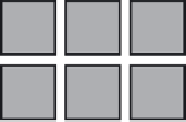Graphics Reference
In-Depth Information
Figure 10.17
The 2D Harr wavelet basis.
1, 0, and 1 are represented by black, gray, and white, re-
spectively. The three “mother” functions are shown at the left; the right image illustrates
some daughter wavelets of increasing frequency. (From [Ng et al. 03] c
−
2003 ACM, Inc.
Included here by permission.)
order SH expansion. One advantage of wavelet approximation, and convergent
approximations in general, is that the coefficients get smaller as the frequency
increases. Consequently, even if the small coefficients cannot be omitted outright,
they can sometimes be included at lower precision, which reduces the storage
requirements.
A commonly used wavelet basis set is the
Harr basis
, which in some sense is
the simplest wavelet basis. Haar wavelets consist of simple step functions having
values
−
1, 0, and 1. In 2D they can visualized as a pattern inside a square. The
left side of Figure 10.17 illustrates the three Haar mother functions (in 2D and
higher dimensions, several mother wavelets are often employed). The right side
of the figure illustrates some child Haar wavelets, which are shifted and scaled
versions of the mother functions. To approximate lighting, what is needed is a
basis set of wavelets on the sphere. The 2D Haar basis can be mapped onto the
sphere as suggested in Figure 10.18: a large cube is centered at the object, and
the Haar basis functions on each face of the cube are projected onto the sphere.
Alternatively, the spherical environment map or radiance function can be pro-
jected onto the faces of the cube and a separate wavelet expansion applied to each
face.
In a paper entitled “All-Frequency Shadows Using Non-Linear Wavelet Light-
ing Approximation,” Ren Ng, Ravi Ramamoorthi, and Pat Hanrahan presented a
method of using wavelet basis functions in place of SH basis functions to rep-
resent high-frequency radiance transfer [Ng et al. 03]. This work was not an
extension to the precomputed radiance transfer method of Sloan et al. of the prior
year. Rather, it presented an alternative method for a matrix representation of (pre-
computed) radiance transfer in a problem the authors call
image relighting
.An
object is assumed to be viewed from a fixed viewpoint under illumination from































